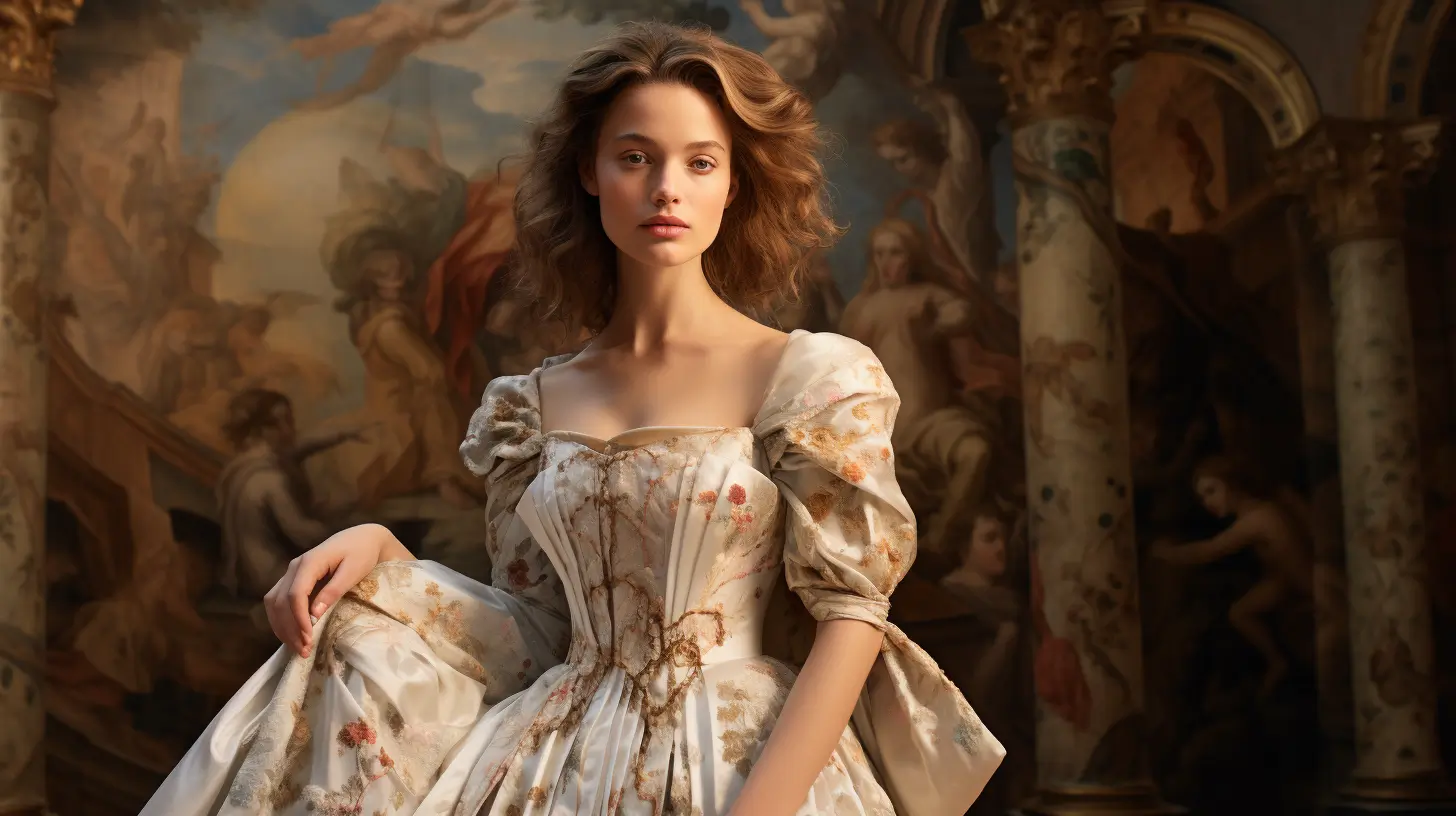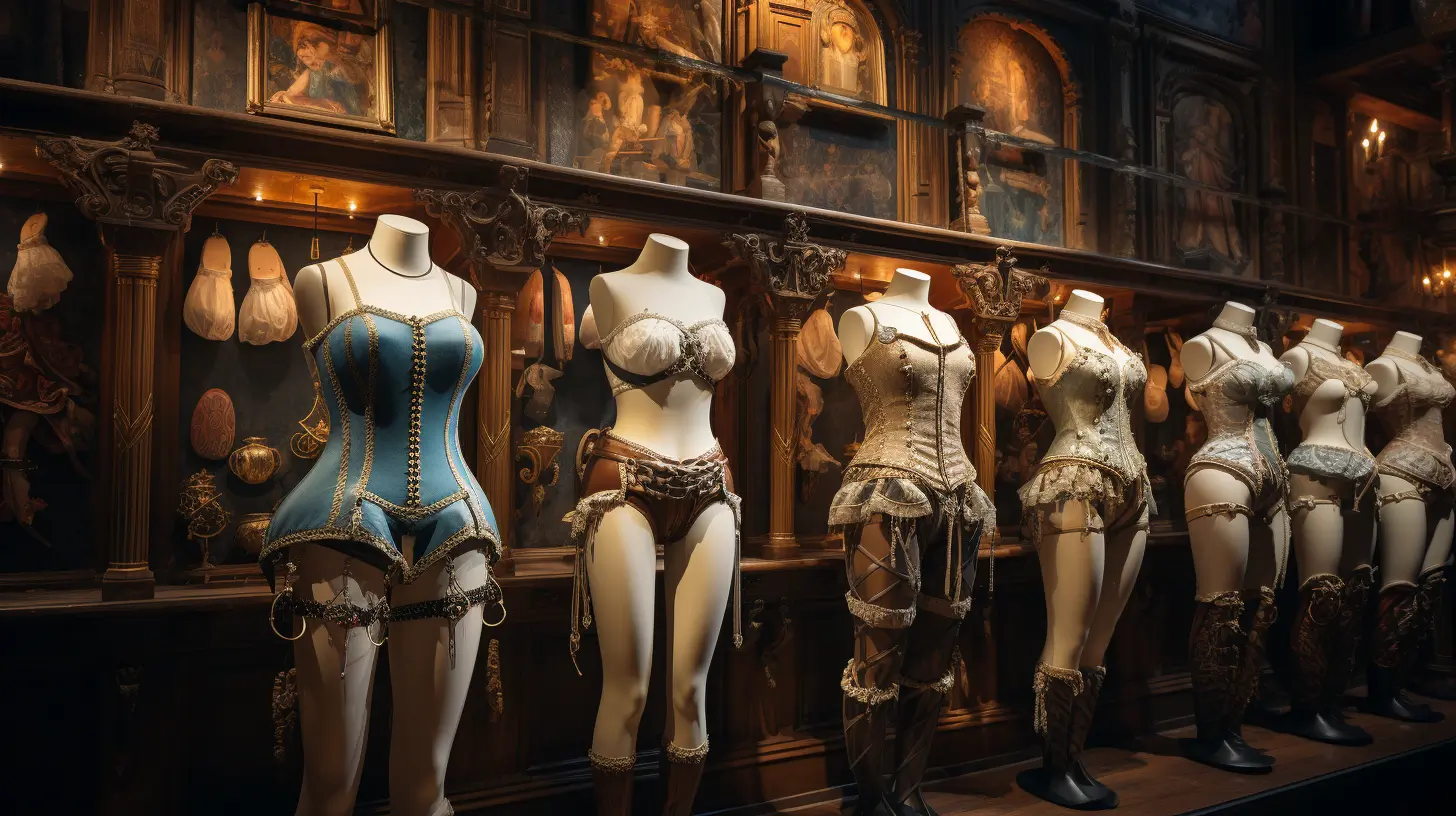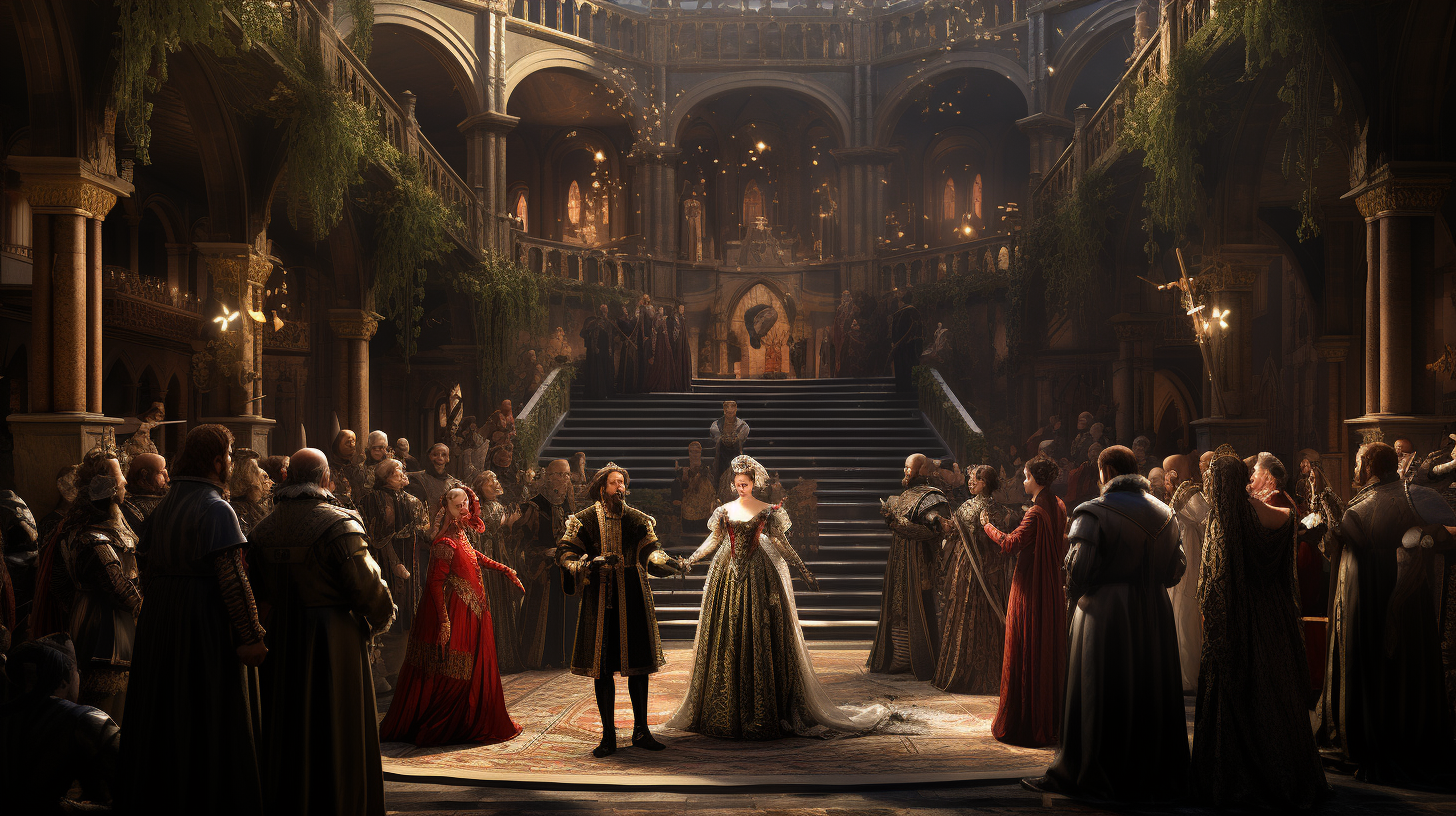
The Bohemian Revolution: Unveiling the Origins of Hippie Fashion
The Birth of Bohemian Spirit
Exploring Bohemian Roots
In the annals of history, one encounters a term, a concept if you will, that evokes a sense of rebellion, artistic freedom, and a desire to break free from the constraints of societal norms. Ladies and gentlemen, we’re talking about the Bohemian spirit. Originating in the heart of Europe, this term found its footing in the early 19th century.
Imagine the narrow cobblestone streets of Paris, where artists, writers, and free thinkers gathered. They were known as “Bohemians,” a label inspired by the unconventional lifestyle of Romani people who were believed to have originated in Bohemia. These early Bohemians were marked by their rejection of traditional values and their pursuit of creative expression.
Now, picture this: smoky cafes filled with passionate debates, vibrant canvases capturing the essence of life, and individuals draped in attire that screamed nonconformity. The Bohemians of the 19th century sought to break away from the constraints of conventional fashion. Their clothing choices were a statement—a rebellion against the rigid, formal attire of their time.
Tattered cloaks, flowing scarves, and loose-fitting garments became their uniform of choice. They reveled in earthy colors, natural fabrics, and accessories that exuded an air of mystery. The Bohemian spirit was about embracing the beauty of imperfection and celebrating individuality.
Now, as we delve deeper into the evolution of Bohemian and Hippie fashion, remember the roots from which this spirit emerged. The Bohemians of the 19th century laid the foundation for a fashion revolution that would resonate through the ages.
The Influence of Bohemian Spirit on 19th Century Fashion
Embracing Freedom Through Fabric
Picture this, ladies and gentlemen: a time when the world was transforming, and societal norms were under scrutiny. The 19th century was a breeding ground for new ideas, artistic expression, and a yearning for individuality. It was during this era that the Bohemian spirit made its mark on the world of fashion.
Unconventional, daring, and resolutely anti-establishment, the Bohemians of the 19th century were trailblazers in their own right. They championed the cause of artistic expression over conformity. As we delve into their influence on fashion, one thing becomes abundantly clear: fabric became a powerful symbol of freedom.
In an era where restrictive corsets and tightly-laced dresses were the norm, Bohemian fashion dared to be different. Bohemian clothing was a stark departure from the structured, formal attire that dominated society. Flowing, unstructured garments crafted from natural fabrics like linen and cotton became the canvas for self-expression.
Imagine garments that allowed wearers to move freely, to dance with abandon, and to breathe. Loose-fitting blouses and billowy skirts that swayed with every step—this was the fashion of Bohemians. Earthy tones, inspired by nature, replaced the rigid palette of the aristocracy.
Bohemian fashion was a declaration of independence—a rebellion against the constraints of the time. It celebrated the individuality of those who wore it and sent a clear message: fashion could be a powerful form of self-expression.
As we continue our journey through Bohemian and Hippie fashion history, remember the Bohemians of the 19th century, their unapologetic embrace of freedom through fabric, and how their influence echoes through the ages.
The Hippie Movement Awakens
An Era of Radical Change
Ladies and gentlemen, prepare to journey back in time to the tumultuous 1960s—a period of profound cultural upheaval. In this transformative era, the seeds of the Hippie movement were sown, giving rise to a fashion revolution that would leave an indelible mark on history.
The 1960s Counterculture was a cauldron of social change, activism, and a rejection of the status quo. It was a time when young people, disillusioned with the norms of the post-war era, sought a different path. This counterculture was a response to the tumultuous events of the time: civil rights struggles, anti-war protests, and a fervent desire for personal freedom.
Picture this, if you will: young minds challenging authority, advocating for peace, and embracing love as a guiding principle. It was against this backdrop of radical change that the Hippie movement emerged, rebelling against the values and conventions of mainstream society.
But how, you might ask, did Hippies express their defiance and ideals? The answer lies in their clothing. Fashion became a powerful tool for protest and self-expression.
Clothing as a Form of Protest: Hippies rejected the consumer-driven, materialistic culture of the time. Instead, they embraced clothing that was imbued with meaning. Tie-dye shirts, with their vibrant and psychedelic colors, symbolized the rejection of conformity and the celebration of individuality. Flower crowns, adorned with colorful blossoms, became a symbol of peace and love, a stark contrast to the prevailing climate of war and conflict.
Loose, flowing garments, often made by hand, became a statement of self-reliance and a rejection of mass-produced clothing. Bell-bottom pants, once considered unconventional, became an iconic piece of the Hippie wardrobe, representing a departure from traditional fashion norms.
As we continue our exploration of Bohemian and Hippie fashion history, remember the 1960s counterculture and the Hippie movement’s use of clothing as a form of protest and self-expression. This era was a catalyst for the free-spirited styles that would define an era.

Image A vivid and dynamic illustration capturing the essence of the 1960s counterculture and the emergence of the Hippie movement. The image features young individuals wearing tie-dye shirts, flower crowns, and bell-bottom pants, gathered in a peaceful, communal setting. Their clothing radiates vibrant colors and a sense of rebellion, symbolizing the rejection of mainstream values and the embrace of peace and love.
The Essence of Bohemian & Hippie Style
Patterns, Fabrics, and Staples That Define an Era
Ladies and gentlemen, as we continue our voyage through the world of Bohemian and Hippie fashion, let us now explore the key elements that set these styles apart and made them icons of their time.
Iconic Bohemian Patterns and Fabrics: Imagine a world where clothing is a canvas for artistic expression. Bohemian fashion was known for its embrace of flowing fabrics, intricate patterns, and vibrant colors that told stories of creativity and individuality. Paisley prints, inspired by Persian and Indian designs, graced dresses, blouses, and scarves, adding an exotic touch to Bohemian attire.
Flowing fabrics such as cotton, silk, and chiffon allowed for comfort and ease of movement. They draped elegantly, giving wearers an ethereal quality. These fabrics were not only comfortable but also a reflection of the Bohemian spirit’s love for natural elements.
Now, let’s shift our gaze to the Hippie Wardrobe Staples: It was a time of rebellion against conformity, and Hippies had their own distinctive fashion vocabulary. Tie-dye, with its kaleidoscope of colors and swirling patterns, became synonymous with the counterculture movement. It was a visual representation of the era’s psychedelic experiences and a rejection of the monotony of mass-produced clothing.
Flower crowns adorned with blossoms and leaves celebrated nature, peace, and love. They were not just accessories but symbols of a collective desire for harmony. And who could forget bell-bottom pants, with their flared legs and unique silhouette? They were a fashion statement that defied convention, adding a touch of rebellion to the Hippie wardrobe.
These key elements were more than just fashion choices; they were statements of identity and beliefs. Bohemian and Hippie fashion transcended the superficial and became expressions of the soul, embodying a desire for freedom, creativity, and unity.
As we continue our journey through fashion history, keep these iconic elements in mind, for they are the threads that weave the fabric of Bohemian and Hippie style.

Image A captivating composition showcasing the key elements of Bohemian and Hippie fashion. The image features flowing paisley-printed garments made of cotton and silk. Tie-dye shirts with vibrant swirls, flower crowns adorned with colorful blossoms, and bell-bottom pants are beautifully arranged in a harmonious display. The colors and textures of these fashion elements evoke a sense of free-spiritedness and artistic expression, capturing the essence of Bohemian and Hippie style.
Cultural Rebels: Freedom, Peace, and Self-Expression
Fashion as a Mirror of the Human Spirit
Ladies and gentlemen, let’s delve deeper into the cultural significance of Bohemian and Hippie fashion, where these styles became not just clothing but symbols of profound ideals.
Embracing Freedom and Individuality: In the tumultuous times of the 19th century and the 1960s, society was undergoing seismic shifts. Bohemian and Hippie fashion were manifestations of a collective desire for personal freedom and self-expression.
Bohemian style, with its flowing fabrics and unconventional patterns, allowed individuals to shed the constraints of structured, conventional attire. It was a declaration of independence, an assertion of the right to be oneself. The attire was an extension of the individual’s personality, a canvas for self-expression that defied societal norms.
Hippie fashion echoed this sentiment of freedom, but it went further. It was a bold rejection of mainstream values and the consumer-driven culture of the time. The tie-dye shirts, flower crowns, and loose-fitting garments were visual statements of nonconformity. They represented a rebellion against the war-torn backdrop of the 1960s, with messages of peace, love, and unity.
Now, consider the connection between fashion, music festivals, and the promotion of peace and love. Hippies gathered at iconic events like Woodstock, where fashion became a powerful medium to convey their messages. The vibrant, colorful attire worn at these festivals served as a visual embodiment of the Hippie ethos.
In essence, Bohemian and Hippie fashion became a mirror of the human spirit. They reflected a desire for a better world, one characterized by individuality, freedom, and a profound longing for peace.
As we continue our exploration, remember that Bohemian and Hippie fashion were not just fabrics and accessories; they were symbols of ideals that left an indelible mark on cultural history.
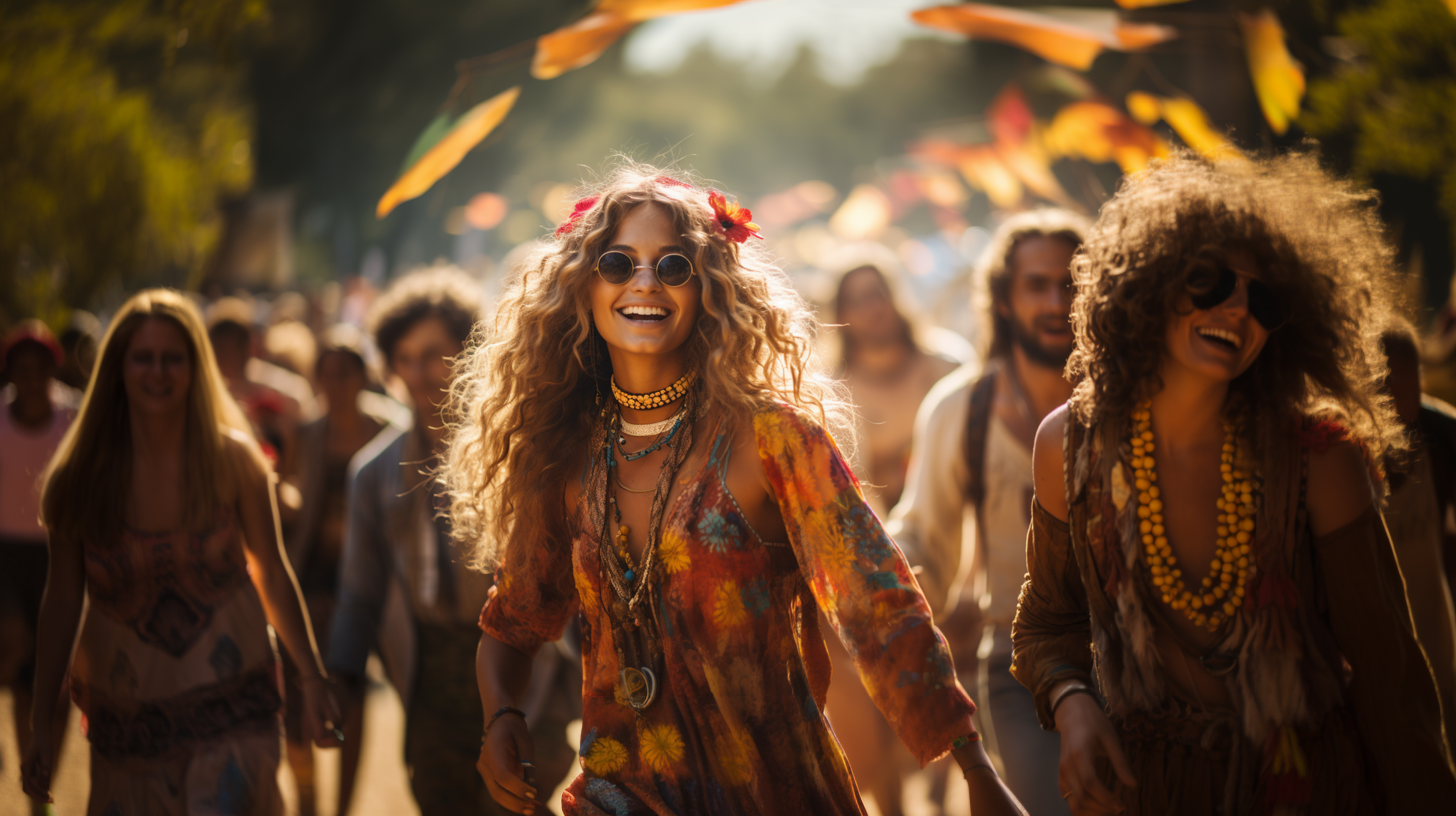
Image A mesmerizing visual representation encapsulating the cultural significance of Bohemian and Hippie fashion. The image features individuals dressed in flowing Bohemian and Hippie attire, standing in a vibrant, peaceful, and music-filled festival setting. The colors, patterns, and expressions on their faces convey a sense of freedom, unity, and the promotion of peace and love. The attire serves as a powerful statement of individuality and rebellion against the mainstream, capturing the spirit of these cultural movements.
Bohemian & Hippie Fashion: A Timeless Influence
Evolving Styles with Modern Relevance
Ladies and gentlemen, our journey through the annals of fashion history brings us to a remarkable revelation: the enduring influence of Bohemian and Hippie fashion on the styles of today.
Contemporary Boho Chic: Consider the allure of Bohemian fashion, with its flowing fabrics, natural colors, and a spirit that celebrates individuality. This iconic style has seamlessly transcended the boundaries of time, evolving into what we now know as “Contemporary Boho Chic.”
Imagine, if you will, a modern city street adorned with fashionable individuals wearing loose, flowing dresses, accessorized with earthy jewelry and layered scarves. The Bohemian spirit of free-spiritedness and self-expression continues to thrive in today’s fashion landscape.
Contemporary Boho Chic retains the essence of Bohemian style but adapts it to the demands of the modern world. It incorporates elements like maxi dresses, fringe details, and wide-brimmed hats, creating a look that’s both casual and chic. The natural color palette, often punctuated by vibrant accents, adds a touch of Bohemian authenticity.
But the influence doesn’t stop there. The values of the Hippie movement, with their emphasis on environmentalism and social justice, remain as relevant as ever in contemporary society.
Revival of Hippie Values: Picture a world where environmental consciousness is a guiding principle, and social justice is at the forefront of our collective consciousness. The Hippie values of peace, love, and harmony with nature have found a new home in today’s world.
Environmentalism, sustainability, and ethical fashion have become integral aspects of modern culture. Consumers are increasingly mindful of the environmental impact of their clothing choices. They seek eco-friendly materials, ethical production methods, and brands that align with their values.
Social justice movements advocating for equality and justice echo the ideals of the Hippie era. Today’s youth, like the Hippies of the past, are agents of change, using fashion and activism to challenge the status quo.
As we journey forward in time, remember that the Bohemian and Hippie spirit lives on in the fashion choices and values of the present. They serve as a reminder that style is not just about clothing but also about the ideals we hold dear.
Image Description:
An evocative image capturing the fusion of Bohemian and Hippie fashion elements with contemporary style. Modern individuals are depicted wearing loose, flowing Boho Chic attire, adorned with natural accessories and vibrant accents. The image reflects a sense of freedom, individuality, and a commitment to environmental and social causes, embodying the enduring influence of Bohemian and Hippie fashion on the present day.
A Captivating Fashion Ensemble
Colors, Patterns, and Freedom
Ladies and gentlemen, let us take a moment to immerse ourselves in the visual extravaganza that is Bohemian and Hippie fashion. Close your eyes and envision a scene that encapsulates the essence of these free-spirited styles.
In this captivating fashion ensemble, picture a Bohemian-inspired dress that dances with the breeze. The fabric, a flowing tapestry of rich colors and intricate patterns, sways gracefully as the wearer moves. Shades of deep burgundy, earthy green, and vibrant turquoise create a harmonious symphony of hues.
The dress is adorned with paisley prints, each curve and swirl telling a story of artistic expression. The patterns seem to come alive, as if they were painted on the fabric by the hand of a master artist. They evoke a sense of wanderlust and a connection to nature.
Accessories play a crucial role in this ensemble. Imagine a wide-brimmed hat made of natural straw, casting a playful shadow over the wearer’s face. Its brim is adorned with feathers, a nod to the Bohemian love for all things natural.
Adorning the wrists are bangles made of aged brass, each one a unique piece of art. They jingle softly with each movement, adding a melodic touch to the ensemble.
But it’s the shoes that truly complete the look. Imagine leather sandals, lovingly worn and weathered, with intricate beadwork adorning the straps. These shoes are not just a practical choice but a statement of the wearer’s connection to the earth.
As we open our eyes and return to the present, remember that Bohemian and Hippie fashion is more than just clothing; it’s a visual symphony of colors, patterns, and freedom. It’s a celebration of individuality and a rebellion against the ordinary.
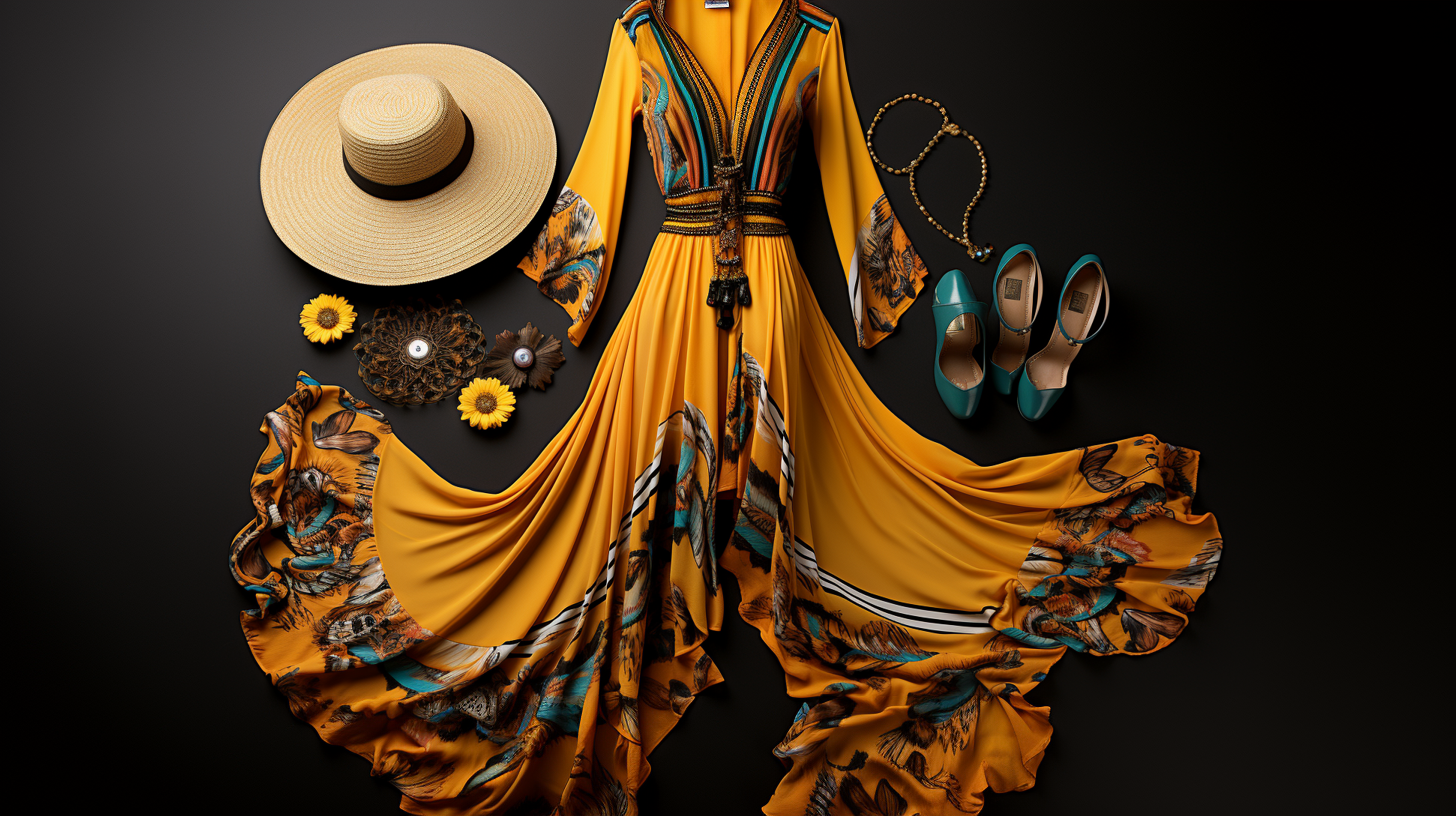
Image A vivid and evocative image capturing the essence of a Bohemian and Hippie fashion ensemble. The ensemble features a flowing dress with intricate paisley prints in rich, vibrant colors. The wide-brimmed hat, adorned with feathers, casts playful shadows. Brass bangles on the wrists jingle softly, and leather sandals with intricate beadwork complete the look. The image reflects the Bohemian and Hippie spirit of freedom, artistic expression, and a deep connection to nature, inviting viewers to step into the world of these iconic styles.
Craftsmanship and Creative Expression
From Intricate Details to Handmade Creations
Ladies and gentlemen, as we delve further into the world of Bohemian and Hippie fashion, let us shine a spotlight on the artistry and craftsmanship that breathe life into these iconic styles.
The Artistry of Bohemian Garments: Picture, if you will, a Bohemian dress—an exquisite work of art in itself. Every stitch, every detail is a testament to the craftsmanship that goes into creating these garments.
Imagine a dress adorned with delicate embroidery, each thread carefully chosen to complement the fabric. The patterns tell stories of distant lands and artistic traditions. Intricate lacework adds an air of elegance, while fringes and tassels bring movement and playfulness to the design.
Bohemian clothing celebrates imperfection, as if each piece was crafted with love and care. It’s about embracing the handiwork and the uniqueness of each garment. The choice of natural fabrics and dyes further highlights the commitment to craftsmanship and authenticity.
Now, let’s shift our focus to the DIY culture of Hippie fashion: Hippies were not just consumers of fashion; they were creators. The DIY ethos encouraged individuals to express themselves through their clothing.
Imagine a group of young people gathered around a communal table, scissors in hand, transforming plain white T-shirts into vibrant tie-dye masterpieces. Flower crowns were handcrafted, with each blossom carefully chosen and arranged. Beads were strung together to create colorful, bohemian jewelry.
Hippie fashion was a canvas for creative expression. It encouraged individuals to tap into their artistic instincts, to embrace imperfection, and to celebrate the beauty of the handmade.
As we continue our exploration, remember that Bohemian and Hippie fashion are not just about wearing clothes; they’re about embracing artistry, craftsmanship, and the spirit of creativity.
Image :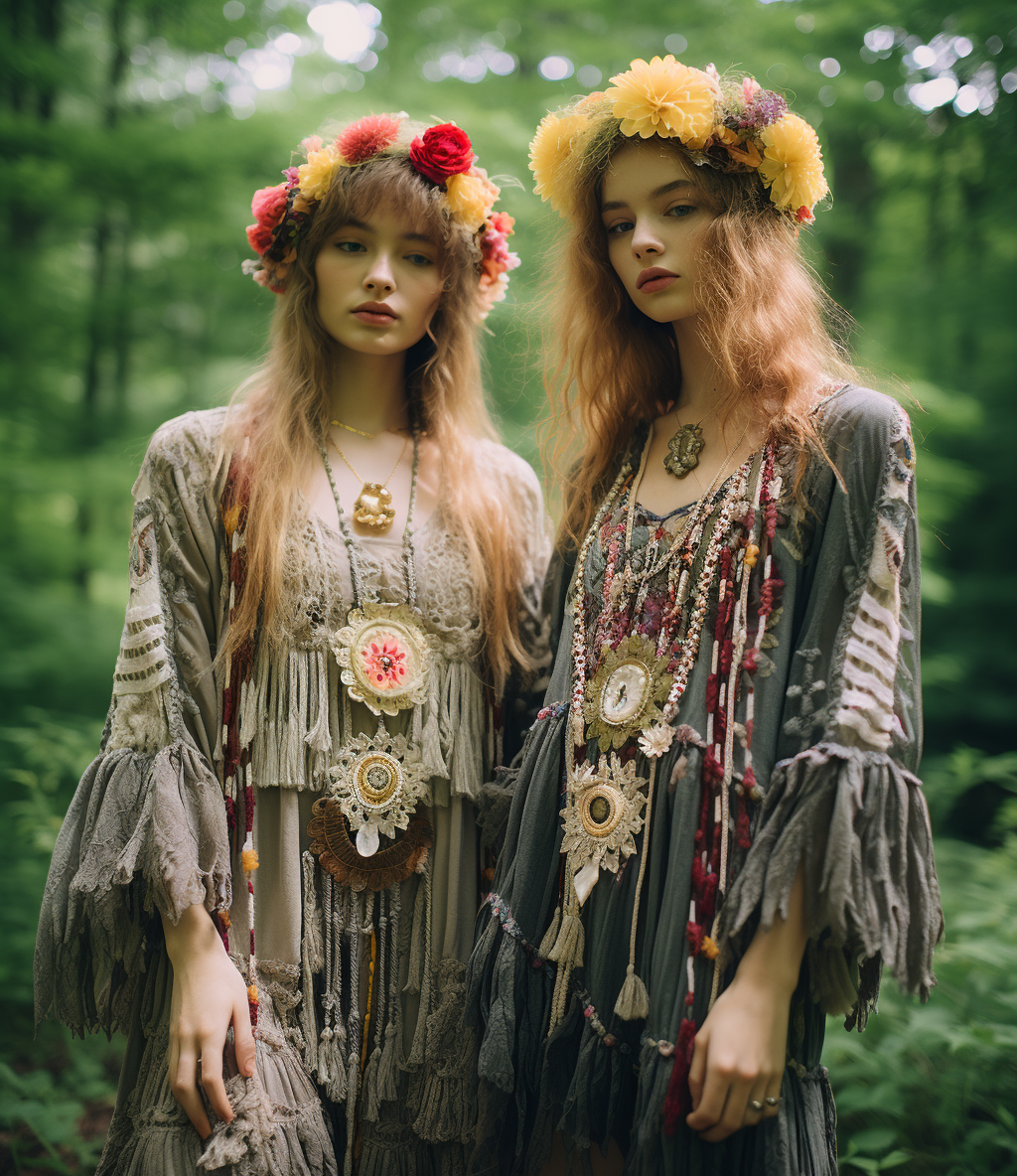
Fashion Across the Ages
A Journey Through Time and Trends
Ladies and gentlemen, our voyage through Bohemian and Hippie fashion history would be incomplete without a closer look at how these styles evolved over time. Let us embark on a journey of fashion time travel, drawing parallels between different eras.
Fashion Time Travel: Imagine a timeline stretching from the 19th century Bohemians to the 1960s Hippies and beyond. Each era has its own unique flavor of Bohemian and Hippie fashion, but the underlying spirit remains the same.
In the 19th century, Bohemian style was characterized by flowing fabrics, paisley prints, and a celebration of individuality. It was a stark departure from the structured clothing of the time.
Fast forward to the 1960s, and Hippie fashion embraced a similar ethos of nonconformity and artistic expression. The tie-dye shirts, flower crowns, and bell-bottom pants became iconic symbols of the era.
Today, in the 21st century, we see the revival of Boho Chic, where elements of Bohemian fashion continue to influence modern style. Loose-fitting dresses, fringe details, and a natural color palette are reminiscent of Bohemian roots.
But it’s not just about the clothing; it’s about the values and ideals that remain consistent across eras. The desire for freedom, individuality, and a rejection of mainstream values transcend time.
As we travel through these different epochs, we find that Bohemian and Hippie fashion are more than just passing trends. They are enduring expressions of the human spirit, a celebration of creativity, and a rebellion against conformity.
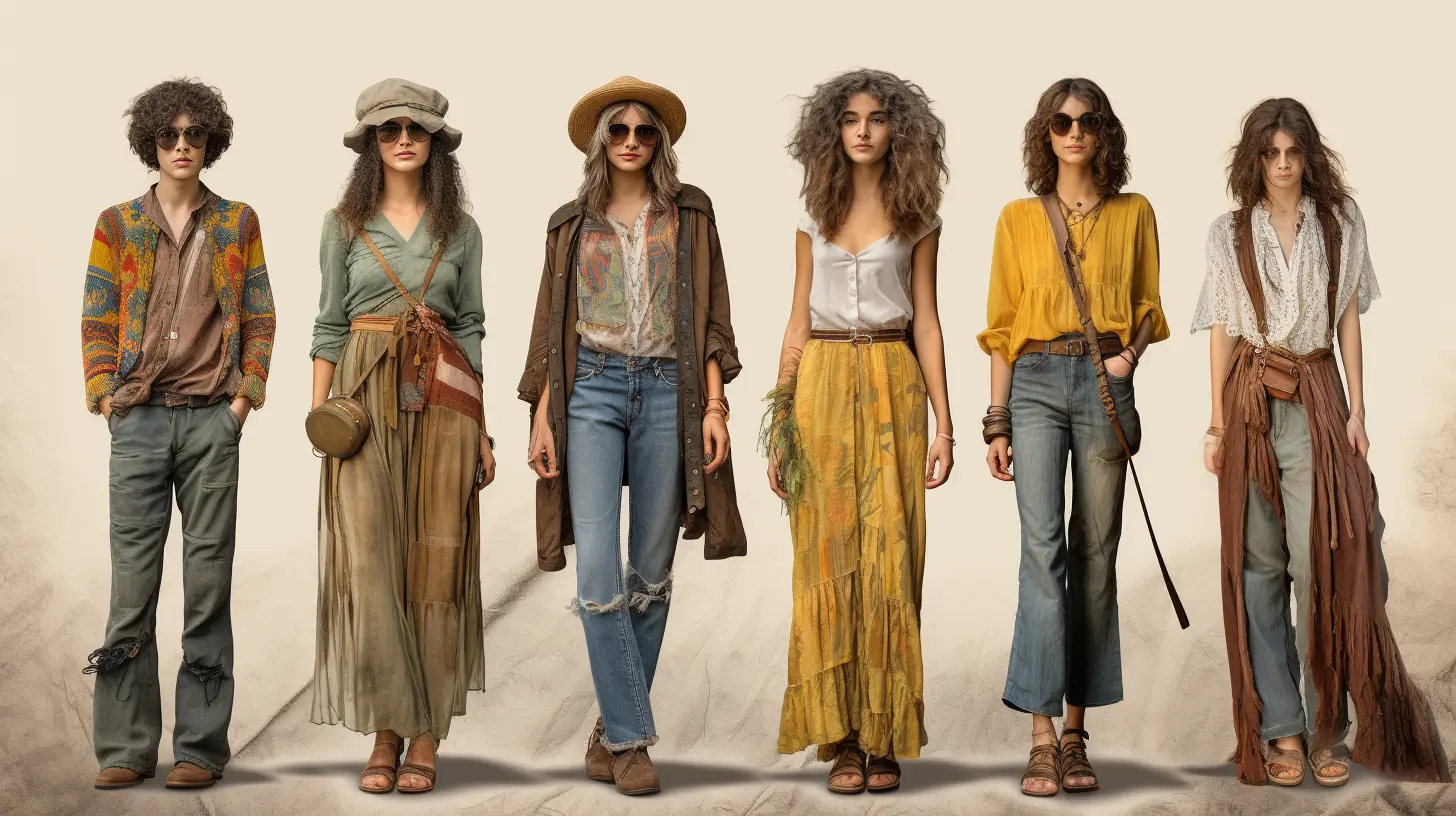
As we conclude our exploration, remember that this blog is not just a repository of knowledge; it’s a gathering place for like-minded individuals who share a deep appreciation for the nuances of Bohemian and Hippie fashion.
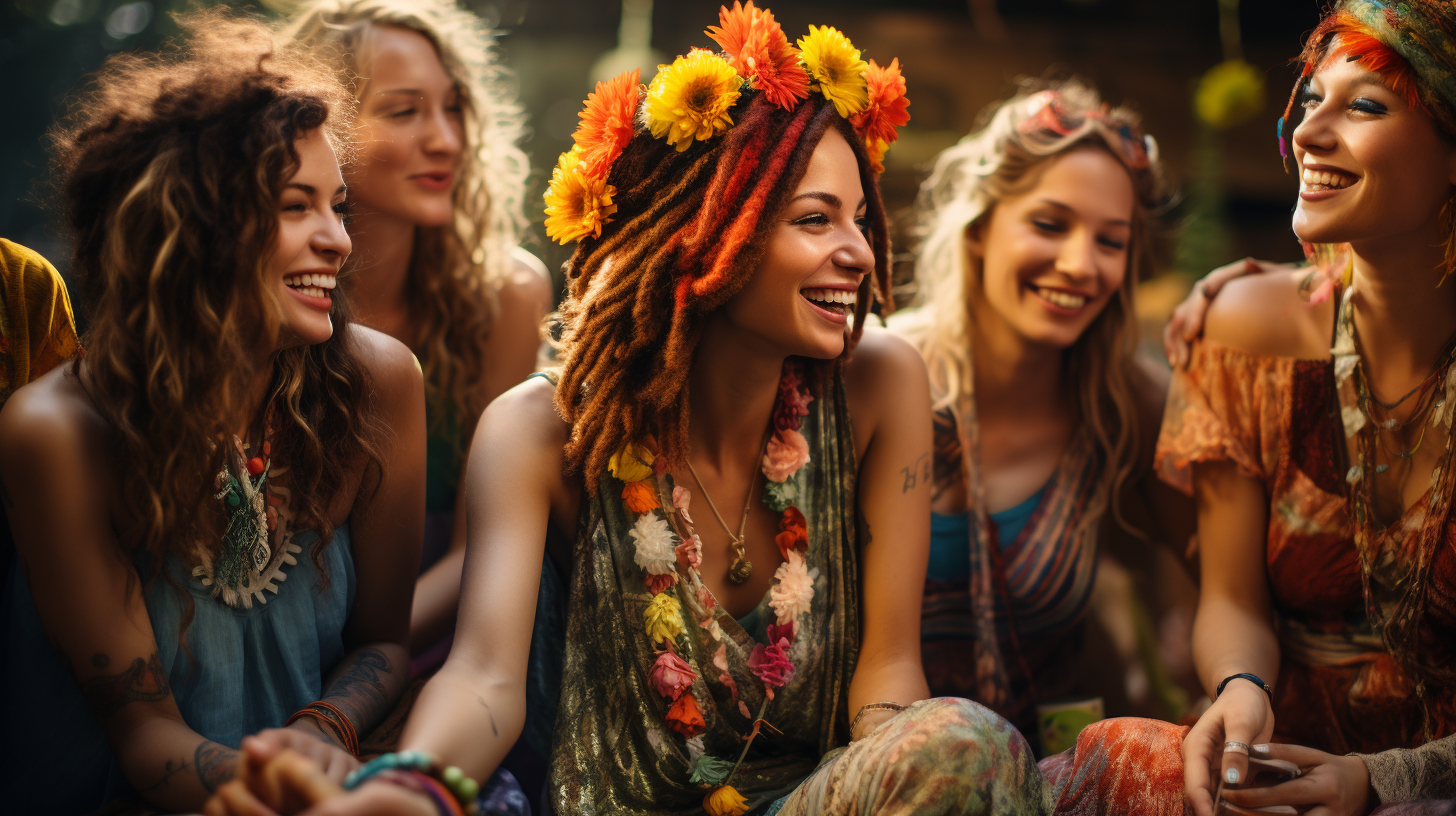
Image A compelling image capturing the essence of a vibrant online community of Bohemian and Hippie fashion enthusiasts. The image features a diverse group of readers engaging in lively discussions, sharing stories and insights related to these styles. Your blog serves as the focal point, a virtual gathering place where kindred spirits from around the world come together to celebrate their love for fashion history. The image radiates a sense of community, belonging, and shared passion, inviting viewers to join the conversation.
A Fashion Journey Beyond Time
Embracing History and Creativity
Ladies and gentlemen, our journey through the eras of Bohemian and Hippie fashion has taken us on a remarkable adventure. We’ve unraveled the stories behind these iconic styles, explored their roots, and witnessed their enduring influence on the world of fashion.
As we reach our destination, it’s essential to reflect on the significance of this journey. Bohemian and Hippie fashion are not merely garments or trends; they are cultural phenomena that have left an indelible mark on the pages of fashion history.
In our exploration of Bohemian fashion, we discovered its origins in the 19th century, where it celebrated individuality and free-spiritedness. We marveled at the intricate craftsmanship of Bohemian garments, their natural fabrics, and their timeless appeal.
The Hippie movement of the 1960s opened our eyes to a world of rebellion, peace, love, and artistic expression. We saw how Hippies used fashion as a form of protest, rejecting mainstream values and embracing a countercultural ethos.
In the present day, we witnessed the revival of Boho Chic, a testament to the lasting influence of Bohemian fashion. We explored how Hippie values like environmentalism and social justice continue to resonate with modern society.
Our journey has not been in vain. It has shown us that fashion is not just about clothing; it’s about self-expression, creativity, and a reflection of societal changes and values.
As we conclude our adventure, I encourage you, dear readers, to continue exploring these styles and their impact on contemporary fashion. Delve deeper into the rich tapestry of Bohemian and Hippie fashion, and discover the stories waiting to be told.


